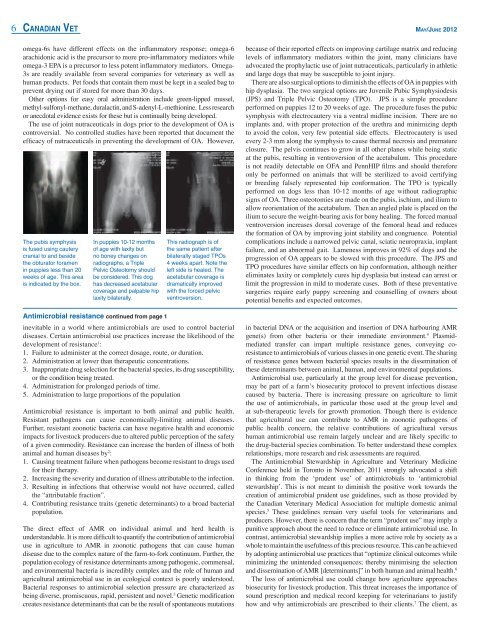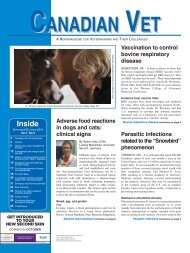canadian vet - K2 Animal Health Publishing
canadian vet - K2 Animal Health Publishing
canadian vet - K2 Animal Health Publishing
You also want an ePaper? Increase the reach of your titles
YUMPU automatically turns print PDFs into web optimized ePapers that Google loves.
6 Canadian Vet<br />
May/June 2012<br />
omega-6s have different effects on the inflammatory response; omega-6<br />
arachidonic acid is the precursor to more pro-inflammatory mediators while<br />
omega-3 EPA is a precursor to less potent inflammatory mediators. Omega-<br />
3s are readily available from several companies for <strong>vet</strong>erinary as well as<br />
human products. Pet foods that contain them must be kept in a sealed bag to<br />
prevent drying out if stored for more than 30 days.<br />
Other options for easy oral administration include green-lipped mussel,<br />
methyl-sulfonyl-methane, duralactin, and S-adenyl-L-methionine. Less research<br />
or anecdotal evidence exists for these but is continually being developed.<br />
The use of joint nutraceuticals in dogs prior to the development of OA is<br />
controversial. No controlled studies have been reported that document the<br />
efficacy of nutraceuticals in preventing the development of OA. However,<br />
Antimicrobial resistance continued from page 1<br />
inevitable in a world where antimicrobials are used to control bacterial<br />
diseases. Certain antimicrobial use practices increase the likelihood of the<br />
development of resistance 1 :<br />
1. Failure to administer at the correct dosage, route, or duration.<br />
2. Administration at lower than therapeutic concentrations.<br />
3. Inappropriate drug selection for the bacterial species, its drug susceptibility,<br />
or the condition being treated.<br />
4. Administration for prolonged periods of time.<br />
5. Administration to large proportions of the population<br />
Antimicrobial resistance is important to both animal and public health.<br />
Resistant pathogens can cause economically-limiting animal diseases.<br />
Further, resistant zoonotic bacteria can have negative health and economic<br />
impacts for livestock producers due to altered public perception of the safety<br />
of a given commodity. Resistance can increase the burden of illness of both<br />
animal and human diseases by 2 :<br />
1. Causing treatment failure when pathogens become resistant to drugs used<br />
for their therapy.<br />
2. Increasing the severity and duration of illness attributable to the infection.<br />
3. Resulting in infections that otherwise would not have occurred, called<br />
the “attributable fraction”.<br />
4. Contributing resistance traits (genetic determinants) to a broad bacterial<br />
population.<br />
The direct effect of AMR on individual animal and herd health is<br />
understandable. It is more difficult to quantify the contribution of antimicrobial<br />
use in agriculture to AMR in zoonotic pathogens that can cause human<br />
disease due to the complex nature of the farm-to-fork continuum. Further, the<br />
population ecology of resistance determinants among pathogenic, commensal,<br />
and environmental bacteria is incredibly complex and the role of human and<br />
agricultural antimicrobial use in an ecological context is poorly understood.<br />
Bacterial responses to antimicrobial selection pressure are characterized as<br />
being diverse, promiscuous, rapid, persistent and novel. 3 Genetic modification<br />
creates resistance determinants that can be the result of spontaneous mutations<br />
because of their reported effects on improving cartilage matrix and reducing<br />
levels of inflammatory mediators within the joint, many clinicians have<br />
advocated the prophylactic use of joint nutraceuticals, particularly in athletic<br />
and large dogs that may be susceptible to joint injury.<br />
There are also surgical options to diminish the effects of OA in puppies with<br />
hip dysplasia. The two surgical options are Juvenile Pubic Symphysiodesis<br />
(JPS) and Triple Pelvic Osteotomy (TPO). JPS is a simple procedure<br />
performed on puppies 12 to 20 weeks of age. The procedure fuses the pubic<br />
symphysis with electrocautery via a ventral midline incision. There are no<br />
implants and, with proper protection of the urethra and minimizing depth<br />
to avoid the colon, very few potential side effects. Electrocautery is used<br />
every 2-3 mm along the symphysis to cause thermal necrosis and premature<br />
closure. The pelvis continues to grow in all other planes while being static<br />
at the pubis, resulting in ventroversion of the acetabulum. This procedure<br />
is not readily detectable on OFA and PennHIP films and should therefore<br />
only be performed on animals that will be sterilized to avoid certifying<br />
or breeding falsely represented hip conformation. The TPO is typically<br />
performed on dogs less than 10-12 months of age without radiographic<br />
signs of OA. Three osteotomies are made on the pubis, ischium, and ilium to<br />
allow reorientation of the acetabulum. Then an angled plate is placed on the<br />
ilium to secure the weight-bearing axis for bony healing. The forced manual<br />
ventroversion increases dorsal coverage of the femoral head and reduces<br />
the formation of OA by improving joint stability and congruence. Potential<br />
complications include a narrowed pelvic canal, sciatic neuropraxia, implant<br />
failure, and an abnormal gait. Lameness improves in 92% of dogs and the<br />
progression of OA appears to be slowed with this procedure. The JPS and<br />
TPO procedures have similar effects on hip conformation, although neither<br />
eliminates laxity or completely cures hip dysplasia but instead can arrest or<br />
limit the progression in mild to moderate cases. Both of these preventative<br />
surgeries require early puppy screening and counselling of owners about<br />
potential benefits and expected outcomes.<br />
in bacterial DNA or the acquisition and insertion of DNA harbouring AMR<br />
gene(s) from other bacteria or their immediate environment. 4 Plasmidmediated<br />
transfer can impart multiple resistance genes, conveying coresistance<br />
to antimicrobials of various classes in one genetic event. The sharing<br />
of resistance genes between bacterial species results in the dissemination of<br />
these determinants between animal, human, and environmental populations.<br />
Antimicrobial use, particularly at the group level for disease prevention,<br />
may be part of a farm’s biosecurity protocol to prevent infectious disease<br />
caused by bacteria. There is increasing pressure on agriculture to limit<br />
the use of antimicrobials, in particular those used at the group level and<br />
at sub-therapeutic levels for growth promotion. Though there is evidence<br />
that agricultural use can contribute to AMR in zoonotic pathogens of<br />
public health concern, the relative contributions of agricultural versus<br />
human antimicrobial use remain largely unclear and are likely specific to<br />
the drug-bacterial species combination. To better understand these complex<br />
relationships, more research and risk assessments are required.<br />
The Antimicrobial Stewardship in Agriculture and Veterinary Medicine<br />
Conference held in Toronto in November, 2011 strongly advocated a shift<br />
in thinking from the ‘prudent use’ of antimicrobials to ‘antimicrobial<br />
stewardship’. This is not meant to diminish the positive work towards the<br />
creation of antimicrobial prudent use guidelines, such as those provided by<br />
the Canadian Veterinary Medical Association for multiple domestic animal<br />
species. 5 These guidelines remain very useful tools for <strong>vet</strong>erinarians and<br />
producers. However, there is concern that the term “prudent use” may imply a<br />
punitive approach about the need to reduce or eliminate antimicrobial use. In<br />
contrast, antimicrobial stewardship implies a more active role by society as a<br />
whole to maintain the usefulness of this precious resource. This can be achieved<br />
by adopting antimicrobial use practices that “optimize clinical outcomes while<br />
minimizing the unintended consequences; thereby minimising the selection<br />
and dissemination of AMR [determinants]” in both human and animal health. 6<br />
The loss of antimicrobial use could change how agriculture approaches<br />
biosecurity for livestock production. This threat increases the importance of<br />
sound prescription and medical record keeping for <strong>vet</strong>erinarians to justify<br />
how and why antimicrobials are prescribed to their clients. 7 The client, as





